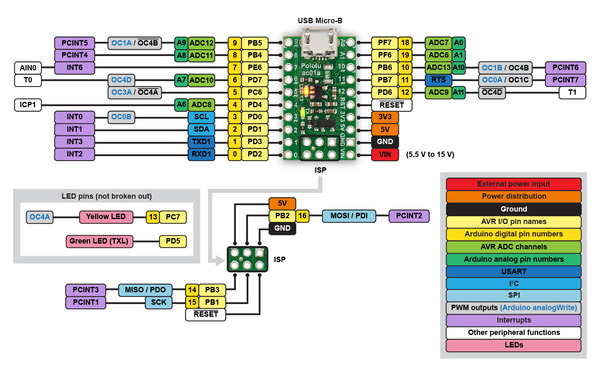Support » Pololu A-Star 32U4 User’s Guide » 3. A-Star 32U4 Micro »
3.1. A-Star 32U4 Micro pinout and components
Pinout
 |
The diagram above identifies the I/O and power pins on the A-Star 32U4 Micro; it is also available as a printable PDF (409k pdf). For more information about the ATmega32U4 microcontroller on this board, see Atmel’s ATmega32U4 documentation.
Printed on the A* circuit board are indicators that you can use to quickly identify each pin’s capabilities: a triangle next to the pin means it can be used as an analog input, and a square wave symbol under the pin number means it can be used as a PWM output.
LEDs
The A-Star 32U4 Micro has two indicator LEDs.
The yellow LED is connected to Arduino pin 13, or PC7. You can drive this pin high in a user program to turn this LED on. The A-Star 32U4 Bootloader fades this LED on and off while it is waiting for a sketch to be loaded.
The green LED is connected to PD5 and lights when the pin is driven low. While the board is running the A-Star 32U4 Bootloader or a program compiled in the Arduino environment, it will flash this LED when it is transmitting data via the USB connection.
Connectors
The A-Star 32U4 includes a USB Micro-B connector that can be used to connect to a computer’s USB port via a USB A to Micro-B cable (not included). The USB connection can be used to transmit and receive data from the computer, and a preloaded USB bootloader makes it possible to program the board over USB. The USB connection can also provide power to the A-Star.
The board also has a 6-pin ISP header that allows it to be programmed with an external programmer, such as our USB AVR programmer v2.1. Pin 1 of the header is indicated with a small white dot and has an octagonal shape. Three of the pins on this header can be used as an SPI interface or as general-purpose digital I/O, as shown in the pinout diagram. In the Arduino environment, you can refer to these three pins using either their pin numbers or the names of their SPI functions (which are defined as aliases); for example, digitalRead(15) and digitalRead(SCK) are equivalent.
Power
The A-Star 32U4 Micro can either be powered directly from the USB 5 V supply or from a separate source on the VIN pin. The board features a power selection circuit that allows both USB and VIN to be connected at the same time; if this is done, the A-Star will draw power from VIN.
USB power input: The A-Star can be powered from the USB 5 V bus voltage (VBUS) if it is connected to a USB cable. It will draw power from USB only if VIN is disconnected. A resettable PTC fuse on VBUS makes it less likely for the A-Star (and the connected computer or other device) to be damaged if too much current is drawn from the USB connection.
VIN power input: The A-Star can be powered from VIN if you connect a 5.5 V to 15 V power supply (such as a battery or wall power adapter) to the VIN and GND pins, with the positive terminal connected to VIN.
When powering the A-Star 32U4 Micro from VIN, a minimum voltage of 5.5 V is required to ensure that the board’s 5 V supply is stable. Even if power is being provided to the A-Star via USB, connecting a voltage higher than 0 V but lower than 5.5 V to VIN is not recommended, as this can interfere with the power selection circuit and cause the 5 V line to drop (potentially triggering a brown-out reset).
5V power output: This pin provides access to the board’s 5 V supply, which comes from either the USB 5 V bus voltage or a low-dropout (LDO) regulator on VIN, depending on which power source is connected. The regulator can supply up to 100 mA, although some of this is used by the board itself (typically about 25 mA) or used to provide current for the GPIO pins or 3.3 V power output (see below).
3V3 power output: This pin gives access to the output of the internal 3.3 V regulator inside the ATmega32U4. The microcontroller uses this regulated voltage for USB signaling, but up to about 50 mA is available for powering external circuits or devices.
When the A-Star 32U4 Micro is being powered through VIN, the sum of the 5V output current, 3V3 output current, GPIO output current, and current used by the board itself should not exceed the 100 mA that the regulator can provide.























